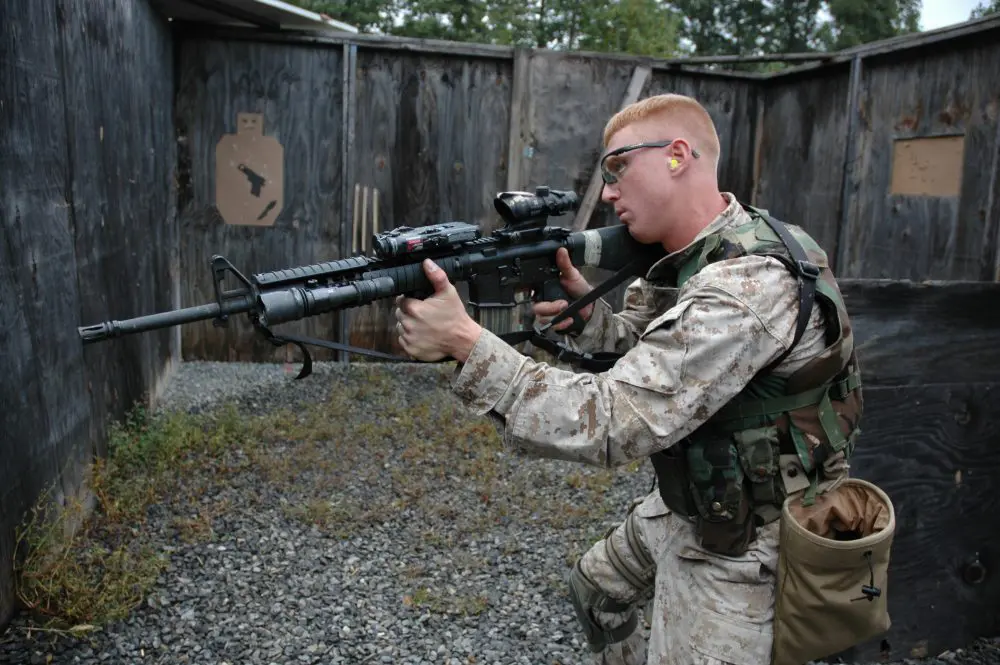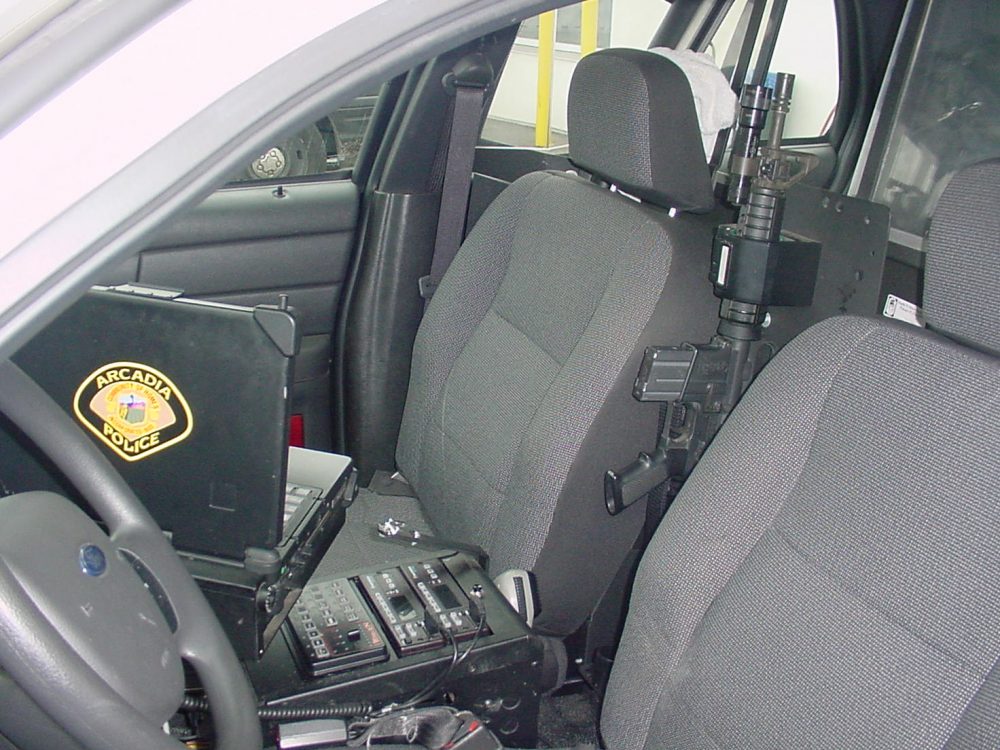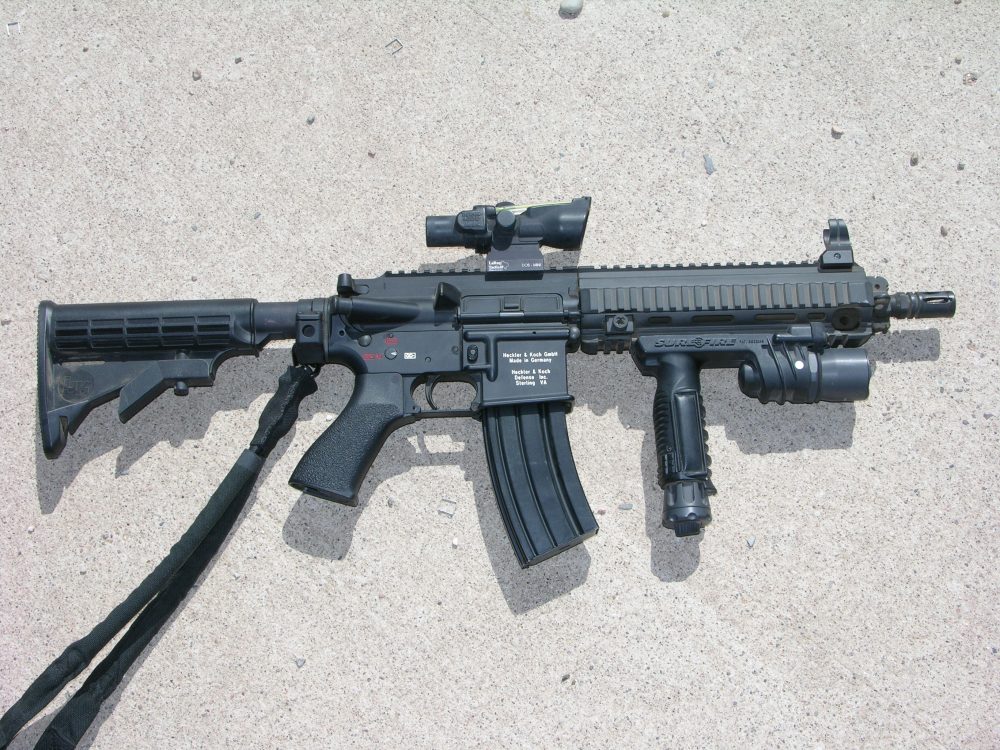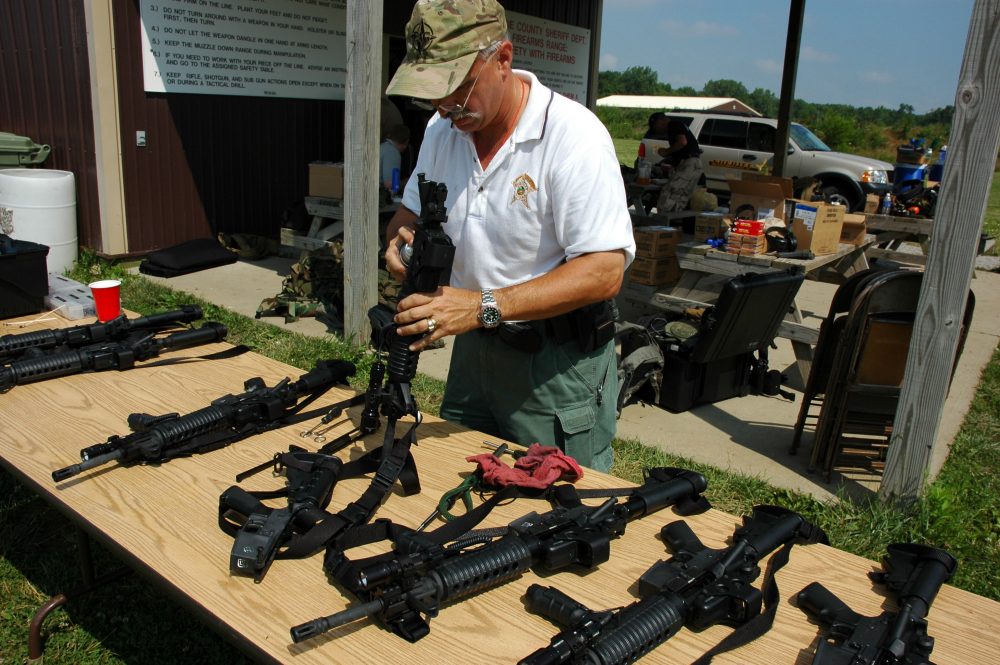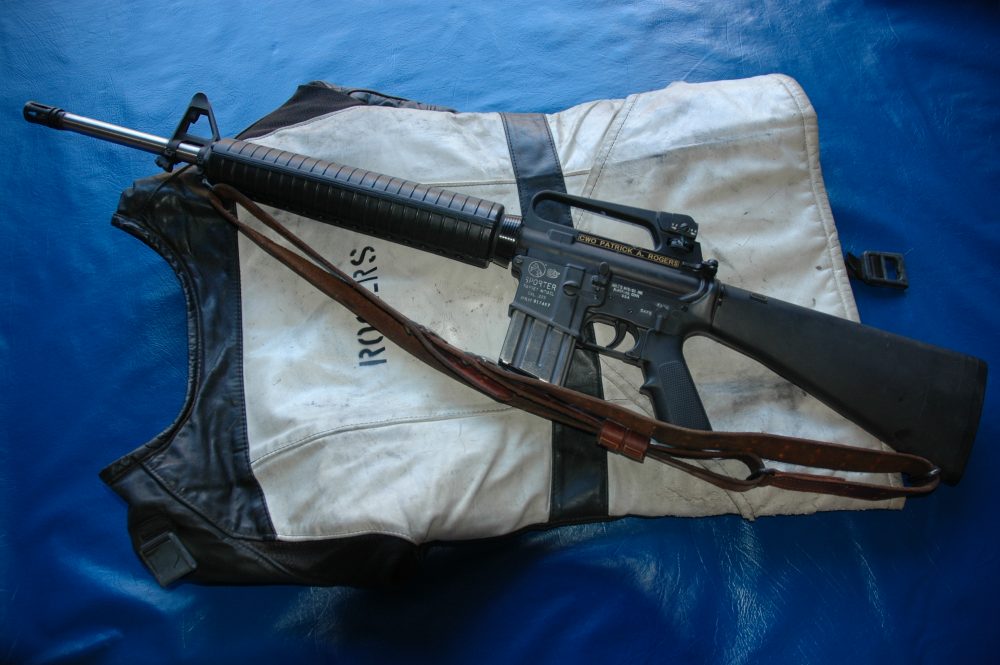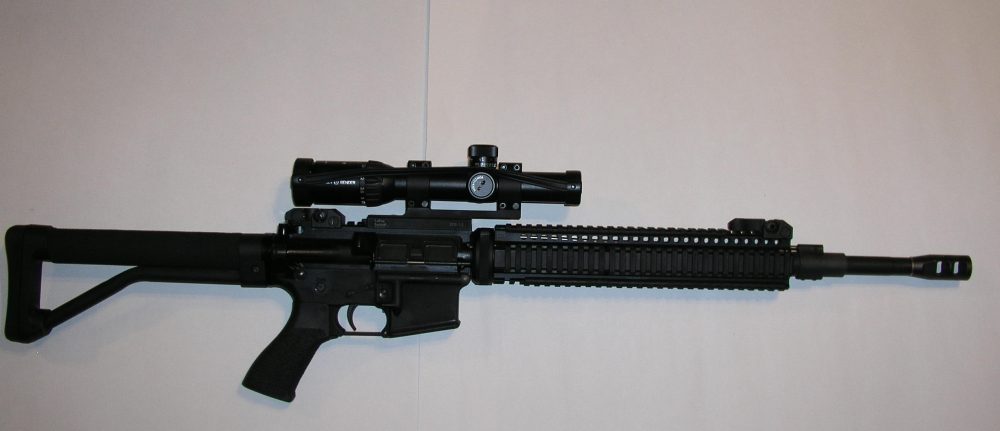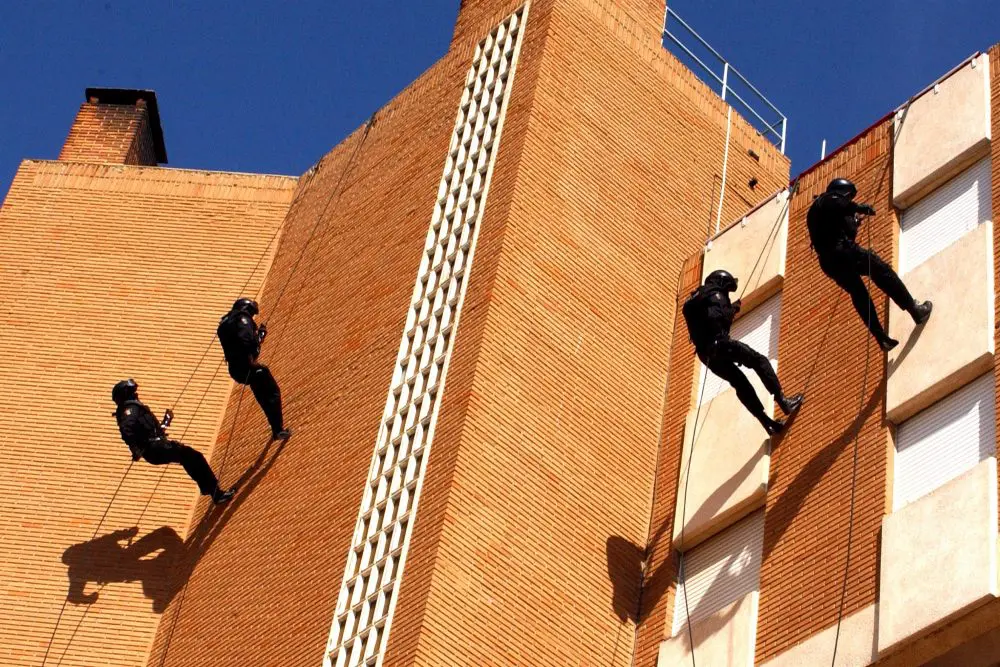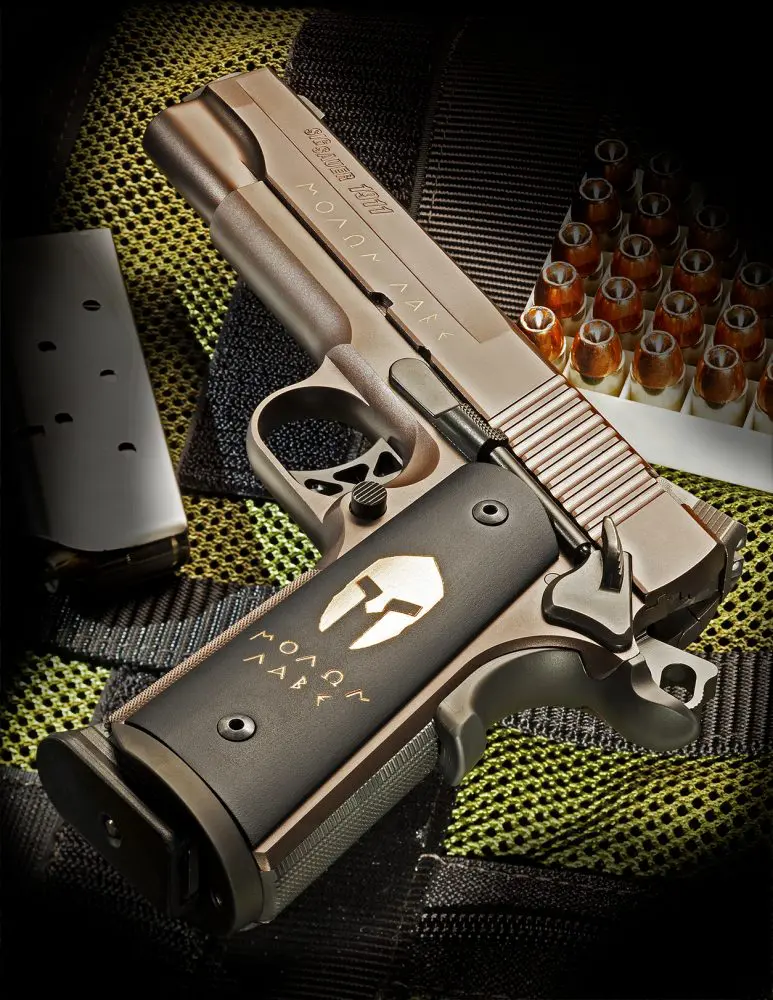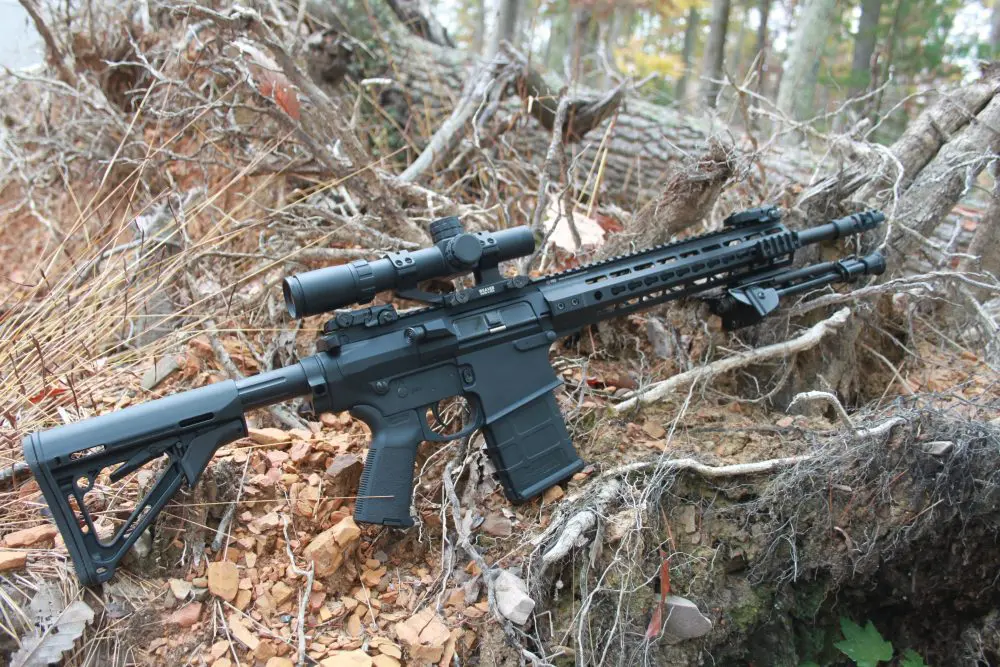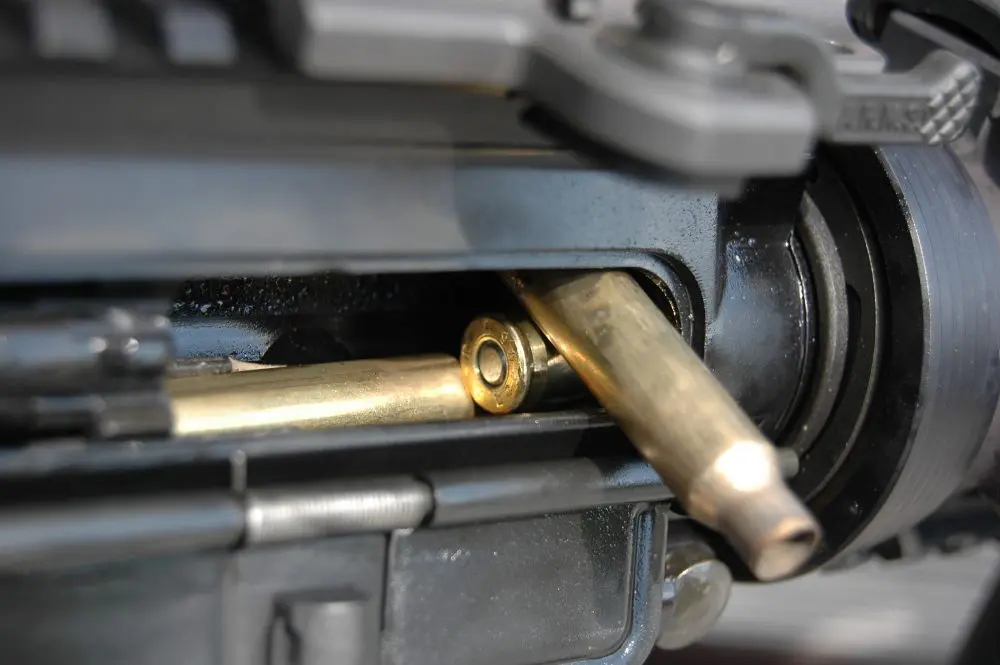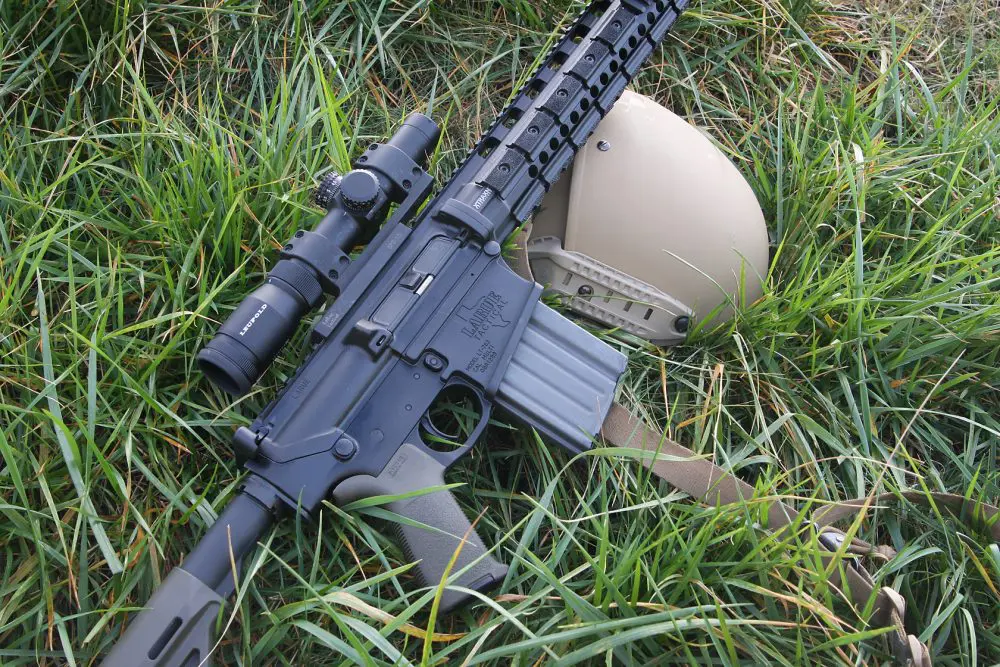Arcadia, CA PD has 11.5-inch Colt Commando in/on every unit. Sgt. Dean Caputo wanted 5.56 Carbine that could be easily accessed, slung and a round chambered while seated in the car. Cop would be ready to fight when he exited, a significant advantage over those agencies that carry them in the trunk. This setup is a compromise for several reasons, but is as close to being perfect for their mission requirements as he could get.
A recurring question, hotly debated in the errornet forums and gun stores everywhere, is what constitutes a “perfect” carbine.
Opinions fluctuate widely according to peer pressure. One forum (populated by those with little practical experience) believes that only a bare bones circa 1963 gun is acceptable. Another forum (populated by a few with real experience) attempts to hold in check a population that wants everything on their carbines—especially if the gear is new, and no matter that they have neither an idea how nor the training to use it.
Located in the center are those who may actually use their carbines, be they military, police, private citizens or competitive shooters.
There is in fact no middle ground on this, nor should there be! We are all prisoners of our frame of reference, and that is as it should be—with some exceptions.
Different jobs, vocations, competitive disciplines and hobbies require different hardware. Examples of this are that an Infantryman requires a certain type of weapon and sighting equipment. A member of a Special Operations team doing a Direct Action hit in search of a High Value Target may need something else entirely.
A cop on patrol might have a carbine in his car, but a SWAT cop in the same department might have his carbine configured differently.
Fed uses 416 with SureFire M900 light—easily the most capable of the weapon-mounted white lights. Trijicon Mini ACOG is mounted on top. In this case, Larue Mount replaced OEM mount- a wise choice. Single point sling is attached to TangoDown PR-4 mount—another good choice. This mount is more expensive than a receiver plate, but permits ambidextrous as well as central mounting option. And you don’t have to take gun apart to fit it.
A collector may want a representation of a period piece, as issued, and specific to a particular time.
Competitors run the gamut from High Power Service Rifle shooters to 3-Gun shooters. In the case of the former, he will have what looks something like an M16A2, but with highly modified sights, a free float tube under the handguards, a 4.5-pound trigger and sufficient lead weight added to bring the rifle up to 13-14 pounds. The sling could be a leather Turner M1907 type, and the barrel a stainless steel behemoth.
The latter might have a much lighter trigger, two optical sights, a muzzle brake that does its job well (at the expense of increased muzzle blast), free float tube and other game-unique additions.
Probably the majority of ARs in the civilian world—with the exception of some competitive shooters—are not regularly used. They may be brought to the range occasionally, cleaned and admired often (and maybe too much of each), but with rare exceptions most are not rode hard and put away wet.
In these cases what the carbine is (make, model) and what is on their carbine could be the result of multiple inputs, possibly including cable and broadcast news reports, magazine articles, Internet communication, personal preference, disposable income, and so on.
Everyone will have valid concerns and desires when it comes to adding equipment to or modifying their guns. The problems arise when proponents of one vocation, discipline or game confuse their wants and needs with another. They become vociferous in their opposition to what someone else uses, basing their noise on nothing more than the fact that it doesn’t suit their particular needs. In short, they are afflicted with a form of weapon myopia, and the less they can see, the more they bang their drum.
Caveat Emptor rings as true today as it did when Latin was a viable language. Local SWAT Team purchased uppers as well as two complete guns from manufacturer known for competition guns, not fighting guns. Though guns were spec’d for 5.56 chambers (and barrels were so marked), chambers were in fact .223. In addition to mismarked chambers, extractor spring was the older type and the insert was blue, rather than the correct enhanced carbine extractor spring with black insert. Here, Sheriff Ken Campbell uses Ned Christensen’s Chamber Reamer to bring guns up to spec.
Even within sub groups there is dissension, with some wanting simple and others more capable guns. For example, many patrol officers are issued fairly stock ARs. The rationale can be that police administrators may not want anything unless the lowest common denominator can safely operate it. (In the late 1980s, the Master Instructor at NYPD stated that he was against the issue of semi-auto pistols to cops because “they are too stupid to operate them.”) In other cases, it may be cash driven. In some cases the decision may be based on knowledge of the system, common sense and good people in charge.
A good case in point is the Arcadia, California, PD. In 1987 they added 9mm carbines to go with the shotguns in their cars. Though some recognized the gross limitations of the 9×19 in a long gun package, others believed it was the best compromise available at the time.
Sgt Dean Caputo took a hard look at newly acquired empirical data and, after lengthy research, in 1996 the Arcadia PD chose and fielded the Colt Commando with an 11.5-inch barrel (this was prior to the North Hollywood incident). Every unit in Arcadia PD—marked, unmarked and even motorcycles—has the Colt Commando.
Dean had to overcome a number of issues regarding what and how the carbine going to be used. The Commando was not individually issued, rather it went with the unit. All of the carbines were zeroed by one cop, and then placed in the vehicles. Dean also wanted the carbines to be carried up front, and short enough so that the driver could unlock the mount, sling the gun and chamber a round while inside the car. Unlike other agencies, which bowed to political correctness and the demands of radical community activists to keep the long guns in the trunk, he wanted the cop to be able to exit the unit with the carbine ready for action.
AR-15 Service Rifle for Highpower competition. Equipped with Krieger 1/8 twist barrel, 1/4 MOA rear sight, trigger that breaks like proverbial glass rod and lead weights in buttstock and free float forend, it weighs over 15 pounds. This is a purpose built rifle for competition, and it excels across the National Match Course. Its usefulness starts—and ends—with that.
Keeping the gun up front meant that optical sights were contraindicated. None of the mounts could take optics, so Dean stayed with iron sights- a compromise based on solid input. An additional issue was that, as the guns were not individually issued, it would be tough to hope that every cop would have the same high level of expertise and devotion to care.
As the gun stayed with the unit, the Commandos had to be ambidextrous. The cops in the car could both be right handed, both left handed or there could be one of each. Slings and operational controls needed to be accessible to all.
Caputo had to make some compromises based on a multitude of internal and external inputs, but his patrol rifle program has been highly successful.
The Emergency Service Unit of NYPD went to Ruger Mini 14s in the 1970s for the sole reason that they “didn’t look as militaristic” as M16s. The Minis were Truck guns—that is, they were issued out to the Emergency Service Squad, not individuals.
It wasn’t until the murderous attack on the World Trade Center that ESU purchased a 5.56 carbine for all members—in this case the Colt model R0979 M4 type Carbine with an Aimpoint sight. The times changed and so did requirements, and the sight of cops armed with M4s and dressed out in tac vests and helmets wasn’t as offensive to the masses as the results of the purveyors of a twisted philosophy killing thousands of Americans in an American city.
An oft-repeated refrain is that “they” took a neat 5.5 pound carbine and turned it into a heavyweight multipurpose whatever, loaded down with everything known to man—specifically “tactical doo-dads.” Some will moan about optics and lust for guns that possess only “good ole’ iron sights” (whatever “good ole” means).
3-Gun Carbine belonging to noted shooter and trainer Jason Jones. It has 18-inch Wilson 1:8 barrel with rifle-length gas system, J-P Comp, Larue 12-inch rail and gas block, Troy BUIS, ACE skeleton stock, 1.5lb trigger and S&B Short Dot. This carbine shows its tactical origins—not surprising considering Jason’s background. All guns pictured fill a niche. None are perfect, but all are very good at what they do.
Like most myths, it has some basis in fact. Carrying a gun from your trunk to a covered bench rest on a public range requires little strength. Carrying that same firestick for three or four days over terrain where the contour lines blur is something else again. Weight is an issue for sure.
However, the end state of carrying a carbine—penetrating bad guys with projectiles—may mean that you do need to offset weight for capability. Are you absolutely sure that you’ll only have to engage during daylight? Well then, those lightweight “good ole” iron sights may just do you right. But if you have to use it at night, or in dim light, or indoors at any time, or if your eyes are getting weaker, or you have to put rounds into multiple opponents at close range, then you may need an optical sight, IR laser aiming sight/IR illuminator or visible laser aiming sight
If you want to win, that is. If you aspire to be first loser, love mediocrity, or don’t want to have an edge, go light—real light. It can make it a lot easier for others to police up your lifeless body and inefficient equipment after all is said and done.
Me, I’ll go weapon capable.
Is the primary use of your carbine defense of your domicile/ family? If so, have you ever considered when the burglaries that turn into robberies, assaults, sexual assaults or homicides most often occur?
You guessed it—nighttime. That’s probably why the law considers nighttime burglaries to be more heinous crimes, and why the law in many jurisdictions permits greater latitude in the use of Deadly Physical Force in such cases.
The overwhelming majority of gun owners have received no training. And of those who have, fewer still have trained at night. Without a white light, you cannot adequately perform that oh-so-important first step in the Target Engagement Process—acquisition. And if you do, the second and third parts—identification and engagement—will be likewise extremely difficult to perform.
It is your choice, and what you choose may make no difference at all—or it may mean the forfeiture of your life or those of your loved ones.
Consider some “perfect” carbines…
When I had some property in the high desert, I would go for a daily five miler. Because cell service was minimal to non-existent, the local sheriff’s office was undermanned and covered an area larger than many states, and the desert is not a particularly hospitable place anyway, I carried a gun when doing cardio.
Marine Corps Standard Infantry rifle is M16A4. It is equipped with Trijicon RCO 4x telescope, KAC rail and vertical foregrip, SureFire MU white light and AN/PEQ-2A IR illuminator and laser aiming sight. A4 is too long for much of what the warrior needs to do. MOUT and CQB are possible, but length makes it less than optimal. RCO is an excellent telescope, but its use indoors in low light makes it less useful than an M4 or MK18 with red dot sight.
Understand that this wasn’t necessarily for protection against bipeds—though that was a distant possibility—but rather against critters. Mountain lions, coyotes and other predators were there way before man, and I understand completely that the food chain exists. I don’t want to be on the lower end of it.
To that end I had an older Colt Carbine—slab sided, standard barrel (what some are calling a “skinny” or “pencil” barrel, their minds having been altered by advertising hype into believing that heavy barrels are standard) and a two-point sling. The only alterations were an XS golf ball front sight and an A2 aperture rear. I have no use for the small aperture for anything but Highpower competition. Any shots I needed to take were up close (under 50m) and rapid target acquisition was more important than theoretical polka dot accuracy. I don’t do outdoor cardio at night, so a weapon mounted white light was a non-issue, and I didn’t need an optical sight for low light engagement. Weight was the issue here—a 5.5-pound rifle can get very heavy after a few miles.
For that specific purpose—daytime only, short-range engagement—that particular carbine was optimal for me, and for that use.
This is not a carbine that I would list as first choice for combat, be it Infantry engagement or Direct Action. When the M16 family first saw combat, night vision was relatively new technology, and nighttime firefights were noisy affairs where hits were more the result of luck than skill. That has changed, and will continue to change, as technology meets the emerging threats.
Shift forward a little bit here. Within the confines of my house I keep a carbine handy. Where I reside, crime is minimal, but not unknown, and as you can’t make an appointment to have an emergency, I’ll opt for being prepared. Common crime may not be the only issue here, though. Terrorism is no longer theoretical, and regional events such as Katrina and Rita are cyclic—we will see devastation from their likes again. The attack on the U.S. by Islamo Fascists and Katrina were different on many levels, but both were era-defining events.
Future events may be more or less destructive, depending on who is hurling the arrows. And whether the event is regional or national, if you are in the middle of it, the world as you know it will change in a very short period of time—and your world may never be the same again.
My in-house carbine has an Aimpoint M3 mounted as well as a SureFire M900 light (both in Larue mounts). The Aimpoint has an obscenely capable battery life—I never shut it off. It remains on medium power, and therefore good to go. The SureFire M900 is the most capable of the weapon-mounted lights out there, and while heavy and expensive, the tradeoff is well worth it.
If I need to defend my life or that of a third person under extreme circumstances, I want something that is sufficient to the task—and that specific gun is up to the task.
Before my eyes deteriorated (aging sucks, but beats the alternative) I shot Highpower Service Rifle. I went Distinguished with an M14, but the supremacy of the M16 brought me around to that platform in the late 1990s. It had 1/4 MOA sights, a tiny rear aperture, lead in the buttstock and lead sleeves around the handguard. The barrel was a very heavy, match grade 1:8 twist that shot like the proverbial house on fire. It had a trigger you would die for in service rifle competition—but it might be a trigger that you would die because of in a gunfight. If you are shooting Service Rifle, this is a solid performing gun. For 3-Gun competition, it is useless, and for gunfighting it is a detriment.
Individuals seeking to buy a carbine (or most any other gun) will seek advice from others. Some will go to local gun stores, where the advice may be excellent or may be based on nothing more than what that dealer stocks and has available. Others will go on the errornet, where a great many people will—based on their frame of reference of owning one article—sing its praises or roll it under the bus. Caveat Emptor rings loud here, and the buyer must be cautious. One—or even 100—may not be a good statistical sample. Performance over the long haul by a large number of like weapons will give you a better idea as to overall usefulness.
That data is not easily forthcoming. Periodicals do not have the budget to do the sophisticated testing necessary, and the large volume of public sales that requires such testing does not exist (consider baby seats, refrigerators and the like).
Every maker is capable of turning out a poor article. The Quality Control/Quality Assurance procedures set in place will determine the volume of poor guns. Understand that those selling to the government must perform to a standard, and that inspectors can (and do) enforce those standards. Also understand that while Low Bidder was a common way for agencies to choose an item, Best Value is now a standard for those smart enough to understand the implications. And best value means exactly that—a higher initial price that is offset by higher standards for quality. Lower cost is often a clue that short cuts are being implemented. These may be more efficient manufacturing or something more insidious, and the only way you may ever find out is when your bolt cracks, your gas carrier keys aren’t staked, the 5.56 chamber you spec’d is actually a .223 “match” chamber or the gun flat doesn’t run. And the military/LE sales guy is on vacation and can’t be bothered to take care of the problems that his crappy little company foisted upon your team.
Every maker is also capable of turning out good guns, but some seem to take shortcuts and hedge on the assumption that most gun buyers shoot very little—if at all.
I once had the opportunity to watch two European gun writers show up for a carbine class where they were to use a particular maker’s guns.
The guns were there all right, but neither one worked at all. No amount of tweaking could get them functioning. What made it even worse is that when the school called the factory to get two new guns, the response was that there were no more guns available.
Here the factory knew what these guns were for, but apparently completely misunderstood (or were unconcerned) about what the ramifications of poor QC and worse customer service would be.
I see examples of both good and less good guns at every class. Over the years it has led me to understand that there are some guns that are more—and less—likely to work as advertised. My purchasing decisions and recommendations are based on that frame of reference going back three decades.
The search for the “perfect” carbine may be no more attainable than the search for the Holy Grail, and Monty Python’s version may be as viable as Dan Brown’s.
There is no “perfect” carbine. There is no “ultimate” carbine. The carbine—like any other firearm—is only a tool, and you have to decide what it is that makes a particular tool best for your particular mission requirements.
Make your decisions based on reality, and not on what the screen “hero” uses to slay hordes of zombies. If you see something that you don’t like on another’s gun, keep your pie hole in check and avoid the keypad until you have a clear understanding as to what it is and why it is needed. Better to keep your mouth shut and let people think you are a fool than open it and confirm everyone’s suspicions.
If you carry/use a firearm for real, cultivate the proper mindset and seek out the best training that you can. Make sure that sustainment training is part of your life. That will be the only way to maximize your equipment and ensure that you win the fight.
It is—and always has been—the singer, not the song.
[Pat Rogers is a retired Chief Warrant Officer of Marines and a retired NYPD Sergeant. He is the owner of E.A.G. Inc., which provides services to various governmental organizations. He can be reached at [email protected]]
